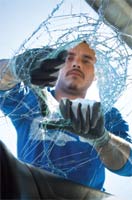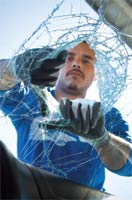
Let Them Know They're In Harm's Way
Clever employees and careless employees make the program hard to enforce. Some try to stretch the use of disposable, one-time-use PPE, and reuse it.
 It was interesting and horrifying to watch
at the same time: a dedicated worker
who, at first glance, was cleaning his
work PPE. On closer examination, he had a
large bucket of tepid water with a wide
range of gloves being dunked and hung up
to dry. These gloves had handled raw
sewage and were moldy from improper
storage after chemicals use or animal blood.
Maintenance liquids such as gasoline,
antifreeze, and oils were all in a dark, murky
soup. All of them were grossly contaminated
inside and out, with no chance of salvage.
The challenge was explaining quietly,
clearly, and without blame why this practice
could not continue and what the danger was
to his health and to others at the workplace.
It was interesting and horrifying to watch
at the same time: a dedicated worker
who, at first glance, was cleaning his
work PPE. On closer examination, he had a
large bucket of tepid water with a wide
range of gloves being dunked and hung up
to dry. These gloves had handled raw
sewage and were moldy from improper
storage after chemicals use or animal blood.
Maintenance liquids such as gasoline,
antifreeze, and oils were all in a dark, murky
soup. All of them were grossly contaminated
inside and out, with no chance of salvage.
The challenge was explaining quietly,
clearly, and without blame why this practice
could not continue and what the danger was
to his health and to others at the workplace.
We see a lot of good intentions gone
wrong in the safety profession. No matter
how tough a situation it is, we as professionals
have to transform it into a learning
opportunity so that the employee is protected
. . . even from himself! This is safety
leadership at its best.
Gloves and hand protection should be
one of our simplest programs in the wide
expanse of safety and health. The availability
of fantastic products at a reasonable
cost in all sizes imaginable makes it seem
easy to put into place. The shelf life and
durability of hand protection is unmatched.
Often, the employee education section of a
great program is the part missing; an
absence of supervisory/management leadership
from the corporate suite that shows
interest in how the PPE is used, cleaned,
and disposed of tells of our failures.
We have all seen it: misuse and abuse of
PPE, employees making poor choices that
limit the effectiveness of their protection.
Some employees have one set of gloves that
they use for everything, no matter what the
situation, causing possibly widespread
contamination or exposing themselves to
irritants, chemicals, or worse. Others clean
with strong solvents (or gasoline), which
may create additional flammability hazards
or weaken the glove materials. Still
others use hand protection as an add-on,
to be quickly taken off and stored away.
Some types of hand protection are
not indestructible; heat can degrade,
inflicting damage that goes unnoticed
and will allow potentially harmful exposures
if the employee does not understand
the PPE limitation or shrugs off
the hazards. Employees (such as health
care workers) get careless and try to save
money or hurry by not changing out
gloves as often as necessary, which can
spread illness and infections rapidly to
patients. Clever employees and careless
employees make the program hard to
enforce. As terrifying as it may be, some
even try to stretch the use of disposable,
one-time-use PPE, and reuse it.
Education and Program Management
Gloves and hand protection are needed by
some in almost every workforce, from
material handling to chemical use, repairs
(such as replacing broken windshields),
handling metal fragments or filings,
cleaning, and in health care, food service,
and high-hazard activities involving radiation.
Many of us need protection from cuts
and abrasions when working with broken
or sharp items. Typical hazards include
punctures, cuts, chemical/toxic material
exposures, vibration, thermal damage, BBP
exposures, and even hazards from using the
wrong glove and thinking it will protect the
worker. Education plays a huge role in a
well-managed hand protection program.=
We frequently focus on the employee
alone for proper use and replacement.
Another key area in the quest for a successful
program is the management.
Workers usually use what is provided and
rarely will use any hand protection at all, if
allowed to forgo it.
Managing a hand protection program is
more than a supervisor tossing a pair of
gloves at an employee. It entails ensuring
each employee knows how to assess the
work situation and protect himself. Management
has to encourage, mentor, and
enforce use.
In terms of supervisor awareness, here
are a few key points to stress:•
Using gloves or hand protection as a
first line of defense. Employees must be
made to understand that the hand protection
is a tool to improve their work safety. They’re not toys and not decorations
for the work belt. Ensuring each
understands why gloves are needed is a
critical focus of any program.
• Hand protection’s limitations. The
protection of any PPE is only as good as
the use. Wearing out-of-service items or
PPE that has been abused will almost
guarantee failure. Make sure employees
understand why they should trade out
gloves and how often they should do so.
Providing real choices that are correct
for the hazard will increase use.
• What are the real hazards in the job,
and which hand protection is the correct
one to use for the situation? With the
wide variety available to you, almost all
hazards are covered.
• How to prevent glove contamination.
There are many dangers to the
user and others when a contaminated
glove is used. Not all gloves or hazards
can be cleaned. Not all contamination
can be seen.
• Proper care of the hand protection.
This includes putting on and taking off
procedures and appropriate disposal.
• How to deal with multiple hazards.
Employees need to understand how to
protect themselves from combination
hazards or once-in-a-while situations
that may call for specialty protection.
• How to adequately wash hands (a
topic often overlooked, in my opinion).
Everyone says he knows about basic
hand sanitation, ranging from hand
gels to soap and water or waterless
cleaners. Rarely, though, do employees
wash up often or well enough before
eating, drinking, or applying cosmetics
on the job site.
It is interesting that something seemingly
as simple as using hand protection
would require extensive management support,
but without it there will be hand
injuries, exposures, and near misses. The
job of the safety professional is to enlighten
management and encourage employees
through education and enforcement to
wear the right PPE all of the time, no
matter what. Sound safety leadership is
challenging and never ending, but the
rewards of improved safety and PPE use
are just one of our goals!
About the Author
Linda J. Sherrard, MS, CSP, is Safety Consultant II with Central Prison Healthcare Complex, NCDPS in Raleigh, N.C., and is the former technical editor of OH&S.